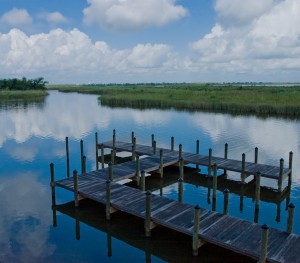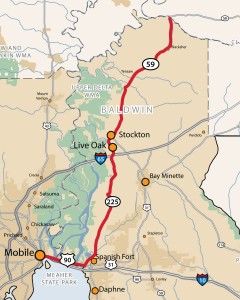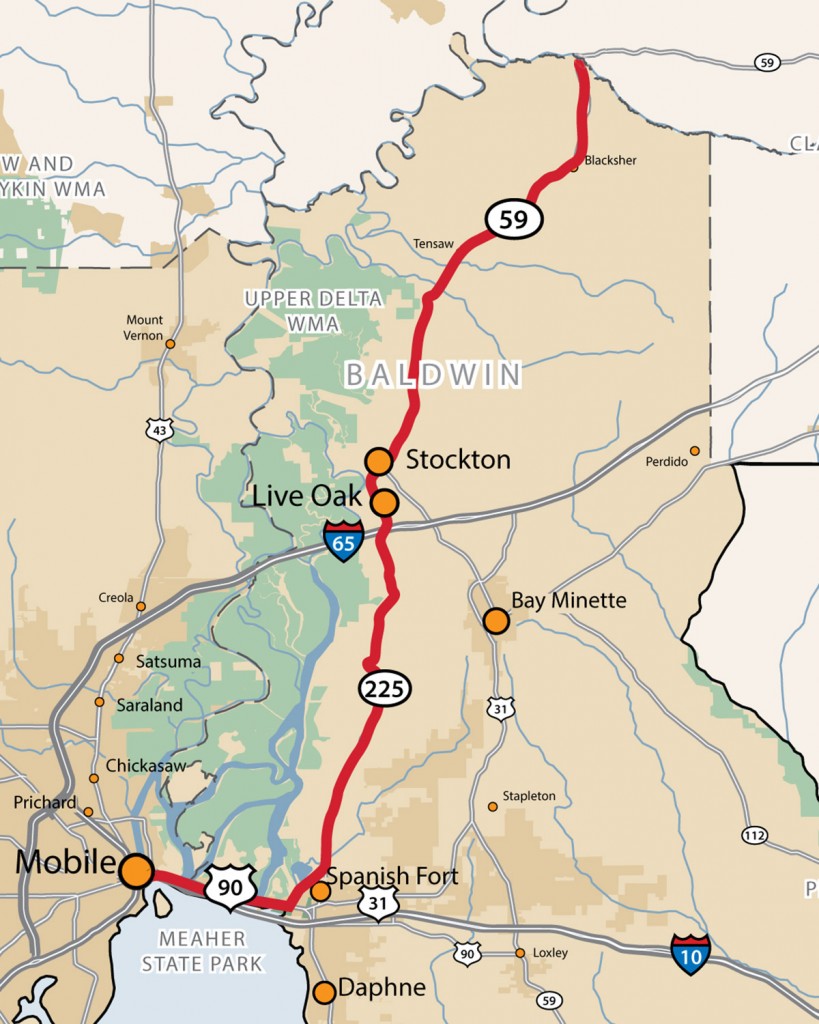Baldwin County, Alabama, founded in 1809, maintains a heritage steeped in the tradition of numerous cultures, inspired by the earliest Native American settlers and expanded through the diverse customs conveyed by European conquerors. The Spanish, French, and British all left their marks on this rich land, ultimately creating a culture uniquely characteristic of the frontier fusion of the Native American way of life and the advancement of European technology. The allure of the region, then as now, is its unique biodiversity, rich farmland, and the ease of transportation provided by abundant waterways. Nowhere is this more evident than in North Baldwin County along what is now the State Highway 225/59 corridor that runs north and south along the eastern perimeter of the Mobile-Tensaw River Delta. Driving along the proposed Tensaw Parkway (State Highway 225/59 corridor) a visitor will quickly understand the immense diversity of attractions that both lovers of nature and history can so earnestly embrace. The corridor’s numerous boat launches and waterways provide almost unparalleled access to the natural beauty of the river delta. Equally, the historic significance of Blakeley State Park and Fort Mims State Memorial Park demonstrate the rich heritage of the county from its colonial origins to the devastation of the nation’s Civil War. The Alabama Coastal Birding Trail and the historic markers that dot the Parkway add to the richness of any traveler’s journey by providing an educational tour, both natural and historic.
The natural resources of the river delta have long attracted settlers with its abundance of fresh and saltwater marine life, timber, game animals, and the ease of travel offered by the areas navigatible waterways. The delta covers over 400 square miles that include rivers and bottom land, swamps and marshes, as well as timberland. According to the Mobile-Tensaw Delta Wetland Conservation Project report, the delta filters the discharge of a watershed comprised of fifteen interior rivers that drain what may be the most geologically and biologically diverse areas in our country. The Alabama Department of Conservation and Natural Resources, which oversees the delta conservation project, maintains that the system which feeds Mobile Bay is recognized as the third largest river system in the United States based on average discharge. As a result, the bio diversity is unrivaled, with over 500 documented species of plants and wildlife that ranges from migrating songbirds to the elusive Florida black bear. This bounty of wildlife can be witnessed from North to South along the Tensaw Parkway. With fourteen boat landings accessible from just off the corridor, the natural beauty of the Mobile-Tensaw Delta can become a part of anyone’s wilderness retreat. Several one-day and overnight canoe trips can be taken such as the Globe Creek Trail, a 6.8 mile water route through creeks, lakes and sloughs. Additional information for these remarkable adventures can be obtained from Outdoor Alabama at their website (www.outdooralabama.com). Furthermore, camping is available along the canoe trails for the routes designated as overnight.
While fishermen may find their way onto the delta at the myriad boat launches, visitors wishing to spend a day on the water exploring the vast delta ecosystem can take advantage of the two hour river tour onboard the Delta Explorer which is scheduled through and disembarks from Blakeley State Park. This fascinating passage is available for school field trips, private charters, and individuals as well. Coupled with the available camping at Blakeley State Park, the great outdoors is accessible from one of the state’s most diverse parks. In addition to the delta tour, the park offers primitive camping at 31 secluded sites, small group camping, and locations for picnicking. Bird watchers will enjoy the parks birding kiosk which contains illustrations and descriptions of some of the birds that may be seen in the park.
Birding enthusiasts can also take advantage of the Alabama Coastal Birding Trail, portions of which follow the Alabama State Highway 225/59 corridor. Considerable bird sanctuaries can be found in the bottom lands that dot the eastern periphery of the Mobile-Tensaw Delta which, in turn, can be accessed from Highway 225/59. Directions from the Tensaw Parkway can be found on the Alabama Coastal Birding Trails homepage (www.alabamacoastalbirdingtrail.com). According to the site the main attraction is the abundance of breeding songbirds, although large waders and kites can be seen in the area. Convenient trail signs mark the routes just off the Parkway for ease of use.
Beyond the natural beauty associated with the Tensaw Parkway, visitors can transport themselves back in time to a period in which Baldwin County was a synthesis of Native American and European cultures; a time when Baldwin County was emblematic of raw, untamed splendor. Most revealing of this combination is Historic Blakeley State Park, Baldwin County Bicentennial Park, Historic Fort Mims State Memorial Park and the William Weatherford (Red Eagle) Park and Gravesite. Each location is representative of the struggle to tame the Alabama wilderness and of the competition between peoples to possess the bounty of the land.
Historic Blakeley State Park’s diversity can be measured in the communities that have called the area home. Around 4,000 years ago the site was a thriving prehistoric Indian village. It later became the location of a French colonial settlement and the home of the Apalachee Indians before their move westward. In 1814 Josiah Blakeley, a Connecticut entrepreneur, chartered the town and began an expansion effort that, at one time, rivaled that of Mobile. Blakeley also served as the county’s first seat of government before yellow fever and land speculation destroyed the growing community. The last major battle of the Civil War was fought at the site on the same day that Confederate General Robert E. Lee surrendered to the Union army in Virginia. Today’s location includes miles of breastworks, remains of earthen forts, old rifle pits, redoubts and battery positions that mark the April 9, 1865 struggle.
Just south of historic Stockton, Alabama and only two miles north of I-65 on State Highway 225, Baldwin County’s Bicentennial Park offers recreational opportunities and a historical perspective of the county’s beautiful wetland. The 367 acre park affords visitors a firsthand view of the river delta’s natural beauty along the walking trail, while the proposed historical interpretations will allow visitors a hands-on experience steeped in the regions farming and timber heritage. Exhibits featuring a 19th century working farm and a Native American village will transcend time as visitors learn what life was like for the first inhabitants of Baldwin County.
Located seven miles west of the Tensaw community on County Road 80 off State Highway 59 is the Historic Fort Mims State Memorial Park, site of the 1813 massacre of settlers by Red Stick Creeks. Estimates by some historians of 500 settler deaths make Fort Mims the most brutal attack in American history. The fighting that took place at Fort Mims resulted from the tension that had grown among the white and red settlers of the Southeast. As Europeans and Americans continued to establish themselves in the region, Native Americans began to see their lives impacted on a grand scale. Acts of violence on both sides intensified culminating with the Battle of Burnt Corn Creek, and later, the Massacre at Fort Mims. At Burnt Corn Colonel James Caller along with 180 territorial militiamen and volunteers attacked some 80 Creek warriors who were returning from Pensacola with arms and ammunition. The fighting at Burnt Corn Creek is believed to have inspired the Creek Red Sticks to attack the white settlers at Fort Mims in retaliation.
Today’s Fort Mims is a peaceful wooded lot operated as a five acre state park which contains a pavilion, and a walking path that follows the footprint of the fort walls with information placards. The most recent addition to the site is the reconstruction of the west wall of the fort which serves as the center piece of a yearly battle reenactment. Each year during a weekend long remembrance historians, reenactors, and the local curious gather to revisit that fateful day in 1813 when the future of an entire region changed as a result of this influential battle. In addition to the yearly gathering visitors easily reach the park on County Road 80 just off Highway 59 at any time of year and enjoy the solitude as they reflect on the lives lost and changed forever nearly 200 years earlier.
Located just a few minutes north of Fort Mims is the final resting place of Creek leader William Weatherford (Red Eagle) who led the assault on Fort Mims. The small park features the grave site of Weatherford and his mother Sehoy III, Princess of the Wind Clan. In 1991 the Baldwin County Commission dedicated the park as the William Weatherford Memorial Park.
Adding to the charm of the Parkway, the Red Hill Spring located north of Stockton is both a natural wonder and a historic stop. This artesian well has provided travelers a cool drink of water since 1922. The spring is accessible immediately off State Highway 59.
The Tensaw Parkway offers a wide range of visual treats whether they are the natural splendor of the river system or the many historical sites that dot the periphery of the Mobile-Tensaw River Delta. The same attractions allow a physical interaction that immerses the visitor in the biodiversity of the river delta and places them in the same pathways tread by early Native Americans, European settlers, and Civil War soldiers. Nevertheless, the question remains; how would a Scenic Byway be beneficial to an area so rich in natural and historic resources? The answer and keyword is sustainability. The Tensaw Parkway would ensure increased exposure to those appreciative of the innate beauty of the region and to those who have yet to hear of the remarkable region. Increased exposure would come through state and national Scenic Byway marketing programs; potential grant funding for preservation, improvements and marketing; and increased visitor spending. In short, the Tensaw Parkway would expose the area to a larger audience, yet preserve the delta’s assets as they exist now.





